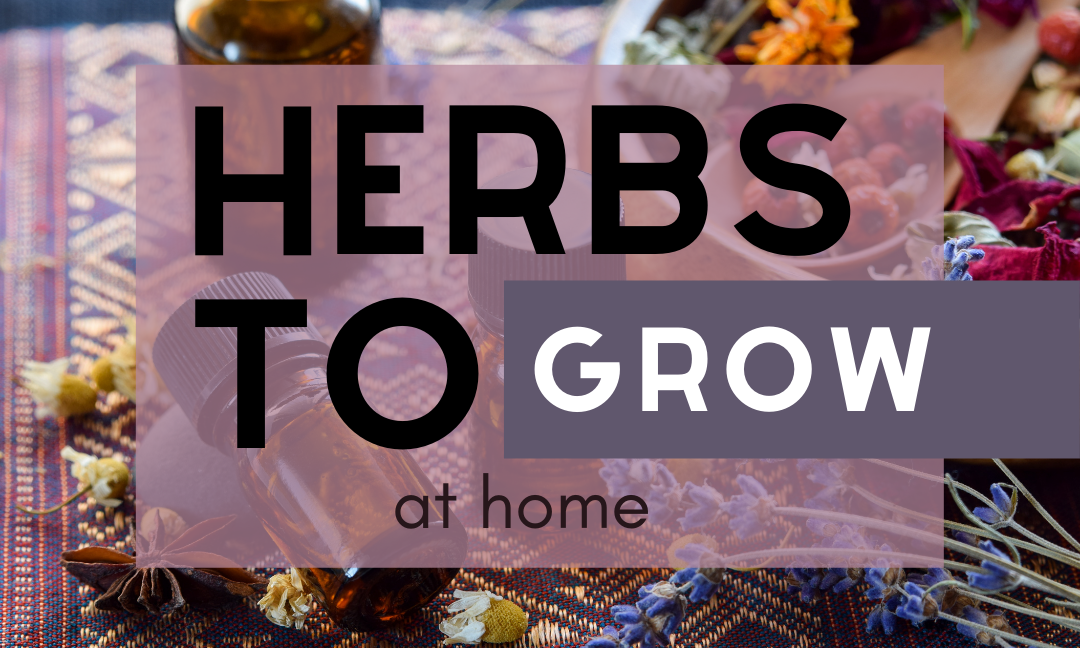Author: Sharon Wei
Editor: Rayna Almas
Featured Image Designer: Emily Sheng
Publisher: Rayna Almas
Picture this: you’re trying out a new recipe for pasta and as you’re savouring it in your mouth expecting a burst of flavour, you frown when you realize it’s practically tasteless. You read the recipe again and there it is, the step you missed – ”add 1 teaspoon finely chopped thyme into the sauce”. Herbs are plants with savoury and aromatic properties used for their flavour, health and spiritual benefits. Don’t underestimate their power, for those small botanicals have the ability to dominate the flavour and fragrance of your favourite dishes!
What’s more, why not cultivate your very own culinary garden! You’d even be contributing less to the environmental impact of commercialized herb manufacturing. Many herbs are easy to grow with proper tending. All you need are some pots, seeds, potting soil, and a sunny place to grow the herbs.
Before we get started, it is important to choose the best pots to ensure success with your herb garden. These are a few tips to keep in mind: use plastic or glazed ceramic pots for herbs in moist soil and clay pots for herbs in drier soil; the pots must be slightly larger than the plant and have at least three drainage holes; 8 to 10 inch pots are perfect for almost any herb while 12 to 18 inch pots accommodate multiple herbs simultaneously.
Without further ado, here are 7 of the best herbs to grow for cooking!
Table of Contents
- Basil
- Cilantro (Coriander)
- Parsley
- Chives
- Dill
- Thyme
- Mint
1. Basil
 Distinct characteristic: The leaves are an ovoid shape and slightly curved upwards.
Distinct characteristic: The leaves are an ovoid shape and slightly curved upwards.
Germination requirements: This herb needs a sunny, sheltered place that receives six to eight hours of sun daily; as well as nutrient-dense and well-drained soils. Basil germinates in 7 to 10 days after planting, and is ready to harvest within three to four weeks. You know the plant needs water when its leaves start to droop.
Its uses in different cultures: European sweet basil is widely found in Italian cuisine whilst Thai basil, lemon basil and holy basil in Asian cuisine. The herb also carries diverse cultural and symbolic significance. For instance, in ancient Greece, basil symbolized loathing, whereas in Portugal, basil plants are gifted to one’s sweetheart or lover on certain religious holidays.
Cultural dishes: Basil pairs excellently with olive oil, cheeses, tomatoes, garlic, and lemon. In Italian cuisine, it is used most famously in the Caprese salad. In Thai cuisine, it is a common ingredient in Thai green and red curries. In Iran, basil is used in Borani Reyhan, a combination of stewed fresh tomatoes, basil and spinach with hints of yogurt cooked into the borani.
Harvesting: Cut basil leaves as needed from the top, to ensure that the leaves grow back as an abundant bush of leaves. Remove basil flower buds as soon as it blooms to avoid affecting the flavour of the leaves. Basil preserves well in oil and can also be frozen.
2. Cilantro (Coriander)
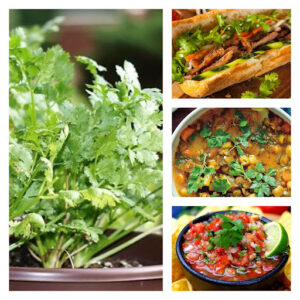 Distinct characteristic: Finely cut leaves that resemble those of parsley, Cilantro is often described to have a soapy taste and a slight stink bug-like odour.
Distinct characteristic: Finely cut leaves that resemble those of parsley, Cilantro is often described to have a soapy taste and a slight stink bug-like odour.
Germination: The herb requires regular watering and well-drained soil. Seeds should sprout in 7 to 10 days. It should be placed in sunny and sheltered spots, however, the herb can grow fairly well in partially shaded areas. Cilantro should not be grown alongside other umbelliferae (ex. parsley, fennel, and chervil).
Its uses in different cultures: It can be added to salads, salsas, soups, stir fries and curries. Coriander seeds are used to flavour sausages, curries, Scandinavian pastries, and confectionery.
Cultural dishes: Cilantro is an important ingredient in Vietnamese pork rolls, Moroccan stew, Thai noodle soup and as an additive to uncooked dishes like guacamole and Mexican salsa. The herb is also used in Persian Herb Stew (Ghormeh Sabzi) and Kuku Sabzi.
Harvesting: Snip off the leaves or whole stems as you need them and the plant will continue to produce. When cutting the stem, snip right next to the base of the plant. Harvesting should be done before flowering as it will lose its aroma and start from the outside stems in, as they are the oldest.
3. Parsley
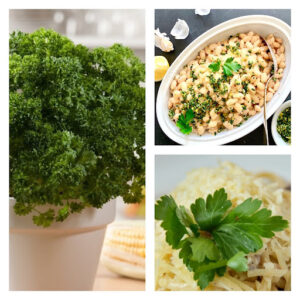 Distinct characteristic: Parsley is dark green coloured with pointy serrations, It has a fresh, grassy smell and a peppery taste.
Distinct characteristic: Parsley is dark green coloured with pointy serrations, It has a fresh, grassy smell and a peppery taste.
Germination: It needs nutrient-rich, well-drained soil that is watered biweekly and a spot that provides plenty of sunlight. As a plant with a deep taproot, this herb will require a larger, deeper pot that is ideally 12 to 18 inches both height and opening diameter.
Its uses in different cultures: Parsley was considered sacred in ancient Greece as it was used to decorate tombs of the deceased and adorned on winners at Isthmian Games. Aside from flavouring dishes, parsley is frequently chopped up and served as a garnish for a pop of green on a dish.
Cultural dishes: It is used in French and Italian dishes, stews, sauces, salads such as tabbouleh, braises, casseroles, and more.
Harvesting: Parsley is enjoyable all season long, as it continues to grow new sprigs when harvested correctly; do not remove more than half of the plant, harvest the leaves from the outside and cut leaves from the base of the stem. It is recommended to harvest before flowers start forming to ensure optimal flavour.
4. Chives
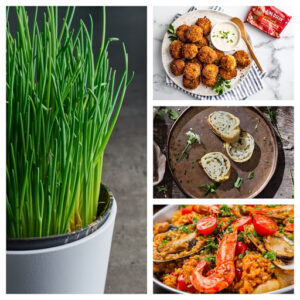 Distinct characteristic: Common chives are clusters of slender, cylindrical hollow leaves, and the aroma is described as a mild onion mixed with a herbal scent.
Distinct characteristic: Common chives are clusters of slender, cylindrical hollow leaves, and the aroma is described as a mild onion mixed with a herbal scent.
Germination: Chives require nutrient-dense, well-drained soil as well as a sunny location, although it is forgiving of dry soil. Sow seeds about 2 inches apart and no deeper than ¼ inch. Avoid planting chives near beans and peas.
Its uses in different cultures: The herb can be used to flavour salads, dips, soups, stews, vinegars, broiled fish and more. Chinese chives are used in stir-fry dishes, spring rolls, and dumpling filling.
Cultural dishes: In Slovenia, želševka is a variation of the traditional Slovenian potica pastry, only with chives as the filling. In Spain, chives are used to garnish fish and seafood plates. In Greece, Fava Croquettes incorporate chopped chives.
Harvesting: Begin harvesting 60 days after seeding and 3 to 4 times during the first year. Cut leaves toward the base about one to two inches above the soil while the purple flowers can be harvested as an edible garnish. Chives can self-sow and overtake a garden unless flowers are removed before they fully develop. The herb can be frozen in an airtight bag for later use.
5. Dill
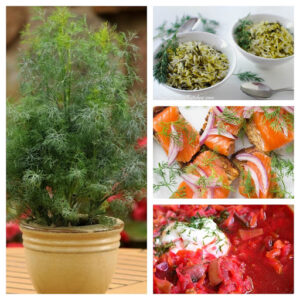 Distinct characteristic: Feathery herb similar to fennel, with small greenish-yellow flowers. Dill tastes like a mix of mild lemon and sweet, with a hint of bitterness.
Distinct characteristic: Feathery herb similar to fennel, with small greenish-yellow flowers. Dill tastes like a mix of mild lemon and sweet, with a hint of bitterness.
Germination: Dill requires a sunny location and nutrient-dense, well-drained soil to thrive. Sow seeds about ¼ inches deep. Seedlings germinate after 10 to 14 days. Avoid planting dill near carrots.
Its uses in different cultures: Dill is used for flavouring soups, salads, sauces, fish, pickles and more. In ancient Greece, dill represented wealth, while Romans considered the herb to be a good luck charm.
Cultural dishes: In Russia, the Russian Borscht with Meat uses dill as a garnish. While in Norway, the Norwegian Salmon Gravlax is cured in a mix of sugar, salt and fresh dill. In Afghanistan and Persia (Iran), fresh dill plays a significant part in a side dish called Chelo Shimit (Rice and Dill).
Harvesting: Both the foliage and seeds can be harvested, but the foliage can be collected any time after the plant has four to five leaves, while the flowers need to mature before collecting seeds.
6. Thyme
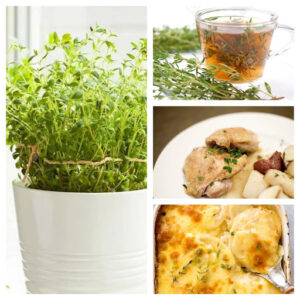 Distinct characteristic: Thyme is described as small, oval, greenish-gray coloured leaves and stiff, woody stems. The herb is highly aromatic with a hint of clove and mint scent.
Distinct characteristic: Thyme is described as small, oval, greenish-gray coloured leaves and stiff, woody stems. The herb is highly aromatic with a hint of clove and mint scent.
Germination: Well-drained soils in 6-inch pots and a sunny location are required to grow the herb. It is easier to plant a sprout than start from the seeds as the germination is slow and uneven. You can plant thyme with rosemary, another herb with similar water needs.
Its uses in different cultures: Thyme is widely used to season soups, stews, casseroles, braises, pizzas, poultry, and stuffings. Romans used the herb to purify their rooms and give flavour to cheese and alcoholic beverages.
Cultural dishes: There is Seombaengnihyang-cha (Ulleungdo thyme tea) in Korea whereas there is Thyme Potatoes Au Gratin and Carpaccio de Thon à l’Huile de Farigoule in France. In Italy, thyme is used in many southern Italian pasta sauces. In the Middle East, it is a staple in za’atar, which is a mix of different dried herbs.
Harvesting: It is best to harvest in the morning when the dew has dried, and clean leaves should not be rinsed for that removes some of the essential oils. Harvest thyme just before the plant starts to flower by snipping off the top five to six inches. The herb can be frozen for later use.
7. Mint
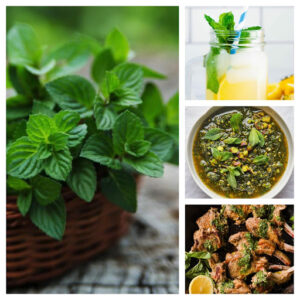 Distinct characteristic: Delicate, dark green leaves with tiny purple, pink or white flowers. Mint is very fragrant with an apparent minty scent.
Distinct characteristic: Delicate, dark green leaves with tiny purple, pink or white flowers. Mint is very fragrant with an apparent minty scent.
Germination: The herb requires a sunny to partially sunny location as well as fertilized and well-drained soil. It is advised to grow each mint in 10 inch pots with drainage holes as their growth must be contained otherwise it might spread all over your garden.
Its uses in different cultures: The herb is commonly used to garnish both savory and sweet dishes for a refreshing kick of mintness on your palate. Mint traditionally complements lamb and poultry, and is used in salads, side dishes and sauces.
Cultural dishes: Popular in North America, there’s nothing better than an iced lemonade with mint on a hot summer day.
Harvesting: Trim stems as needed once the mint grows to 3 or 4 inches tall, or harvest young stems by cutting within 1 inch of the base. You can also just pick the leaves as needed.
With herbs, your dishes can be enhanced with more than just salt and pepper. Why not take your cooking to the next level by incorporating fresh herbs grown in your own herb garden!
Sources:
https://www.live-native.com/basil/#Plant_characteristics_and_classification_of_Basil
https://www.thespruceeats.com/the-history-of-basil-1807566
https://www.delallo.com/blog/cooking-with-basil/
https://web.extension.illinois.edu/herbs/basil.cfm
https://quench.me/magazine/5-asian-herbs-for-your-garden-that-will-dress-up-your-dishes/
https://www.britannica.com/plant/coriander
https://growfully.com/how-to-harvest-cilantro/
https://www.latimes.com/archives/la-xpm-1992-10-08-nc-624-story.html
https://www.schwartz.co.uk/discover/parsley
https://getbusygardening.com/harvesting-parsley/
https://www.thekitchenherbs.com/how-to-harvest-parsley/
https://thrivecuisine.com/taste-test/what-do-chives-taste-like/
https://www.almanac.com/plant/chives
https://www.sciencedirect.com/topics/agricultural-and-biological-sciences/chives
https://persianmama.com/borani-reyhan/
https://www.almanac.com/plant/dill https://delishably.com/spices-seasonings/Flavors-of-the-World-Dill-of-Europe
https://lifeandthyme.com/food/herbs-thyme-for-recognition/
https://www.almanac.com/plant/thyme
https://homeguides.sfgate.com/cut-back-potted-mint-66836.html
https://www.almanac.com/plant/mint
https://herbsathome.co/best-pot-for-herbs/
Images:
https://gardenerspath.com/plants/herbs/homegrown-basil/
https://www.thecookierookie.com/best-caprese-salad-recipe/
https://persianmama.com/borani-reyhan/
https://madhuban.co.uk/thai-red-green-curry
https://plantinstructions.com/herbs/growing-cilantro-indoors/
https://www.123rf.com/photo_30359414_vietnamese-pork-banh-mi-sandwich-with-cilantro-and-daikon.html
https://southerndiscourse.com/fresh-salsa-with-cilantro-lime/
https://www.thelist.com/191971/when-you-eat-parsley-everyday-this-is-what-happens-to-your-body/
https://balconygardenweb.com/growing-parsley-in-containers/
https://www.gardeningknowhow.com/edible/herbs/chives/growing-chives-indoors.htm
https://www.kulinaricna-dozivetja.eu/en/recepti/kruh-in-slano-pecivo/zelsevka/
https://www.killingthyme.net/2020/11/19/crispy-fish-croquettes/
https://www.willcookforsmiles.com/russian-borscht-recipe/
https://balconygardenweb.com/growing-dill-in-pots-dill-plant-care/
https://www.simplyrecipes.com/recipes/how_to_make_salmon_gravlax/
http://www.mypersiankitchen.com/shivid-polow-persian-dill-rice/
https://balconygardenweb.com/thyme-growing-tips-in-containers/
https://www.recipetineats.com/potatoes-au-gratin/
https://behind-the-french-menu.blogspot.com/2015/05/thym-thyme-one-of-most-important-herbs.html
https://www.almanac.com/plant/mint
https://www.bonappetit.com/recipe/pistachio-and-mint-pesto
https://whatgreatgrandmaate.com/mint-chimichurri-lamb-chops/
https://www.acouplecooks.com/lemonade-with-fresh-mint-by-the-glass/

